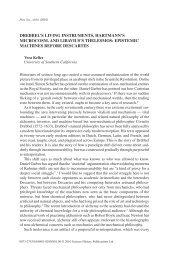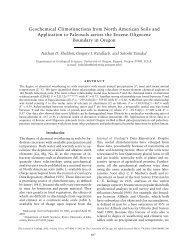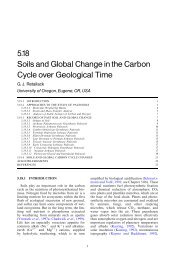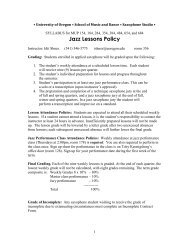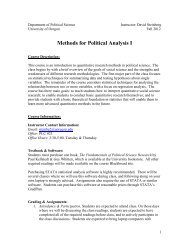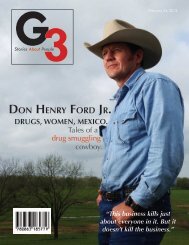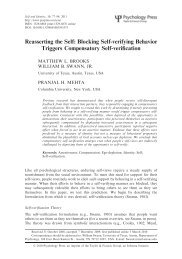Retallack 2007 Proserpina principle - University of Oregon
Retallack 2007 Proserpina principle - University of Oregon
Retallack 2007 Proserpina principle - University of Oregon
You also want an ePaper? Increase the reach of your titles
YUMPU automatically turns print PDFs into web optimized ePapers that Google loves.
2 Soils and Global Change in the Carbon Cycle over Geological Timeand ocean currents (Ramstein et al., 1997) alsoplay a role in climate, but this review focuses onthe carbon cycle. The carbon cycle is discussedin detail in Volume 8 <strong>of</strong> this treatise.The greenhouse model for global paleoclimatehas proven remarkably robust (<strong>Retallack</strong>,2002), despite new challenges (Veizer et al.,2000). The balance <strong>of</strong> producers and consumersis one <strong>of</strong> a number <strong>of</strong> controls on atmosphericgreenhouse gas balance, because CO 2 is addedto the air from fumaroles, volcanic eruptions,and other forms <strong>of</strong> mantle degassing (Holland,1984). Carbon dioxide is also consumedby burial as carbonate and organic matterwithin limestones and other sedimentaryrocks; organic matter burial is an importantlong-term control on CO 2 levels in the atmosphere(Berner and Kothavala, 2001). Themagnitudes <strong>of</strong> carbon pools and fluxes involvedprovide a perspective on the importance <strong>of</strong>soils compared with other carbon reservoirs(Figure 1).Before industrialization, there was only600 Gt (1 Gt ¼ 10 15 g) <strong>of</strong> carbon in CO 2 andmethane in the atmosphere, which is about thesame amount as in all terrestrial biomass, butless than half <strong>of</strong> the reservoir <strong>of</strong> soil organiccarbon. The ocean contained only B3Gt <strong>of</strong>biomass carbon. The deep ocean and sedimentscomprised the largest reservoir <strong>of</strong> bicarbonateand organic matter, but that carbon has beenkept out <strong>of</strong> circulation from the atmospherefor geologically significant periods <strong>of</strong> time(Schidlowski and Aharon, 1992). Humans havetapped underground reservoirs <strong>of</strong> fossil fuels,and our other perturbations <strong>of</strong> the carbon cyclehave also been significant (Vitousek et al.,1997b; see Chapter 8.10).Atmospheric increase <strong>of</strong> carbon in CO 2 to750 Gt C by deforestation and fossil fuel burninghas driven ongoing global warming, but isnot quite balanced by changes in the other carbonreservoirs, leading to a search for a ‘‘missingsink’’ <strong>of</strong> some 1.871.3 Gt C, probably interrestrial organisms, soils, and sediments <strong>of</strong>the northern hemisphere (Keeling et al., 1982;Siegenthaler and Sarmiento, 1993; Stallard,1998). Soil organic matter is a big, rapidlycycling reservoir, likely to include much <strong>of</strong> thismissing sink.During the geological past, the sizes <strong>of</strong>, andfluxes between, these reservoirs have variedenormously as the world has alternatedbetween greenhouse times <strong>of</strong> high carboncontent <strong>of</strong> the atmosphere, and icehousetimes <strong>of</strong> low carbon content <strong>of</strong> the atmosphere.Oscillations in the atmospheric content <strong>of</strong>greenhouse gases can be measured, estimated,or modeled on all timescales from annual toeonal (Figure 2). The actively cycling surficialcarbon reservoirs are biomass, surface oceans,air, and soils, so it is no surprise that thefossil record <strong>of</strong> life on Earth shows stronglinkage to global climate change (Berner, 1997;Algeo and Scheckler, 1998; <strong>Retallack</strong>, 2000a).There is an additional line <strong>of</strong> evidence forpast climatic and atmospheric history in theform <strong>of</strong> fossil soils, or paleosols, now knownAtmosphere 600100 50 50Land biota610Rivers Surface ocean 1,0000.8 Biota 3 1061DOC 700 4 90 100Sediments6Intermediate and deep waters1.2 × 10 70.238,000Organic50Soil & detritus1,5604.8 × 10 7Carbonate0.60.67474Figure 1 Pools and fluxes <strong>of</strong> reduced carbon (bold) and oxidized carbon (regular) in Gt in thepreindustrial carbon cycle. Sources: Schidlowski and Aharon (1992), Siegenthaler and Sarmiento (1993), andStallard (1998).



